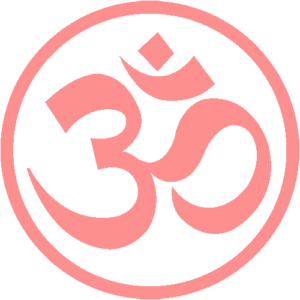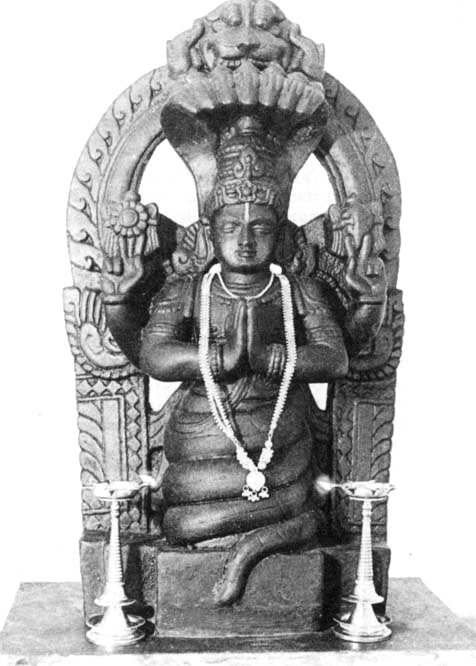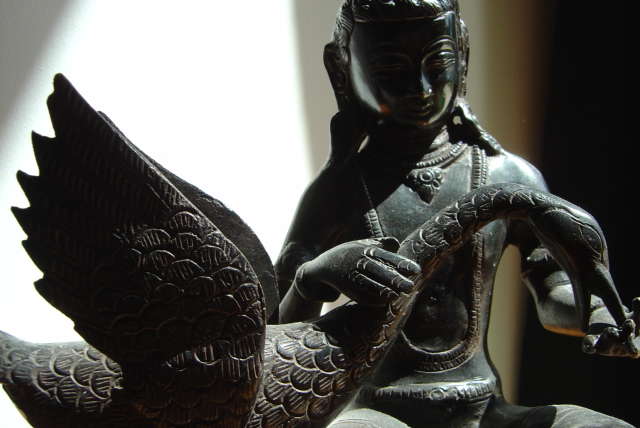YOGA CLASSIQUE – YOGA DES UPANISHAD
Les Upanishad, ou Oupanishad (devanagari : उपनिषद्), sont un terme provenant du sanskrit upa, déplacement auprès de, ni, mouvement vers le bas et shad, s’asseoir ; autrement dit l’attitude de s’asseoir aux pieds d’un Instructeur pour étudier son Enseignement. Ils sont un ensemble de textes organisant la base théorique à la fois mystique et religieuse de l’Inde. Ils font partie de l’ensemble de textes dits de la Shruti (श्रुति (Śruti)) signifiant en sanskrit audition, oreille, connaissance révélée, soit un Enseignement perçu directement sans passer par l’intermédiaire d’un livre ou d’un humain. Leurs spéculations philosophiques mais aussi techniques la plupart du temps éclairent et commentent le texte auquel elles se réfèrent, généralement une partie du Veda.
Traditionnellement, ce qui est nommé la Muktika ou le Canon dans lequel il convient d’étudier les Upanishads selon un ordre bien établi, en dénombre 108 :
- 10 Upanishads Majeures
- 98 Upanishads Mineures parmi lesquelles un sous dénombrement précise
* 27 Upanidhads Générales (Samanayayuvedanta) où la réalité Suprême est appelée Brahma
* 13 Upanishads de Shiva (Shaiva Upaniṣad) où la réalité Suprême est appelée Shiva
* 9 Upanishads de Shakti (Shakta Upaniṣad) où la réalité Suprême est appelée Shakti
* 14 Upanishads de Vishnou (Vaishnana Upaniṣad) où la réalité Suprême est appelée Vishnu
* 19 Upanishads du Yoga (Yog Upaniṣad) décrivant les moyens pour parvenir à la réalisation de l’Unité
* 16 Upanishads du Renoncement (Samnyasa Upaniṣad) où est décrit l’état
du samnyasin, celui qui a renoncé au monde.
Suivant un mode poétique que quelques lettrés ont nommé le style upanishadique, la date de leur rédaction reste approximative, s’étalant selon les diverses sources sur près de 3 millénaires, entre 2000 avant et 1000 ans après notre ère.
Ce n’est que très récemment que les Upanishads ont été prises en considération en Occident, essentiellement au 19ème siècle grâce tout d’abord au philosophe Schopenhauer. Un peu plus tard, dans son ouvrage Ma conception du monde publié en 1961, le célèbre physicien Erwin Schrödinger y présente une métaphysique précisément inspirée des Upanishads !
De façon générale, les Upanishads expriment une vérité au-delà de l’entendement, insistant haut et fort, et selon la formule répétitive de chaque couplet du Nirvana Satakam rédigée par le grand Shankaracharya, Chidananda rupah, shivoham, shivoham, Je suis pure conscience et félicité suprême, je suis Shiva, je suis Shiva.
Ce qui est étonnant dans ces énoncés est le constant rejet de toute idée ou affirmation que nous sommes ceci ou cela, à l’instar de Ramana Maharishi qui répétait souvent à ses disciples que toute la Connaissance pouvait se résumer ainsi : « Je ne suis pas le corps ; qui suis-je ? Je suis Lui » (deham naham ; koham? Soham).
Qu’en est-il alors des apprentis yogis d’aujourd’hui trouvant un intérêt croissant dans la pratique corporelle et chérissant tout nouvel apport de postures, variantes, séries et modifications nombreuses aux asana classiques qui sont assez très peu nombreuses telles que décritent dans les textes traditionnels. ?
Il existe cependant parmi les 19 Upanishads du Yoga et les 16 Upanishads du Renoncement, un enseignement très complet sur la pratique de ce qui a été appelé par Patanjali Raja Yoga ou encore Asthanga Yoga (à ne pas confondre avec une mode récente utilisant le même terme pour des séries posturales intenses, parfois acrobatiques).
Patanjali, auteur du célèbre traité des Yoga Sutra, auxquels bon nombre de professeurs et formateurs de yoga contemporains se réfèrent encore, dénombre 8 domaines (Asthanga) de la vie où la réalité suprême peut être perçue et réaliser de façon durable qu’il nomme Yama, Niyama, Asana, Pranayama, Prathyahara, Dharana, Dhyana, Samadhi ( Absentions vis-à-vis du monde extérieur, Observances vis-à-vis de soi-même, Discipline corporelle, Contrôle des forces vitales, Rétraction sensorielle, Concentration, Contemplation continue, Unité)
Ce célèbre traité contenant 196 courts aphorismes possède en outre la particularité de pouvoir être indéfiniment commenté. Sa structure et son organisation grammaticale permettant toute sorte de traductions, certaines très techniques, d’autres plus philosophiques, ou métaphysiques ou encore poétiques, ce qui en soi, relève d’un véritable prodige de l’auteur, par ailleurs également auteur de traité de politique générale, de grammaire sanskrite et de poésie. Il est généralement considéré qu’il naquit dans le village de Gondarmau dans l’actuel Madhya Pradesh et rédigea ce traité vers environ entre 400 avant et 200 après notre ère, sa date de naissance restant approximative.
Ce texte considéré comme une référence absolue dans le monde du Yoga d’aujourd’hui pose cependant quelques questions à des chercheurs exégètes quant à sa source et son inspiration.
Ainsi, il se trouve parmi les Upanishads des écrits qui pourraient être plus anciens que le traité de Patanjali et à partir desquels il se serait inspiré ! La particularité des ces Textes est de non seulement définir eux aussi l’Asthanga Yoga, mais aussi d’en donner les pratiques et les exercices dont Patanjali ne fait jamais mention dans son Yoga Sutra. Par la suite également apparaissent d’autres écrits faisant référence à Asthanga Yoga et donnant des pratiques concises et des explications détaillées quant à la succession des exercices, des durées de la pratique et des effets servant de repère à la bonne mise en place des dits exercices.
On y trouve notamment :
- le YogaYagnavalkyam, provenant de la région de Trivandrum (Côte du Malabar) apportant une réconciliation entre la point de vue sur la méditation brahmanique et la doctrine tantrique du salut.
- Le Yogavashistham, considéré par certains lettrés comme le plus ancien traité de yoga
- La Sandilya Upanishad donnat avec une rigoureuse précision les divers tracés de l’énergie dans le corps et les techniques respiratoires qui s’y réfèrent
- La Jabala Darshan Upanishad donnant quant à elle de nombreux détails sur les différents huit domaines de l’Asthanga Yoga.
C’est cette dernière, la Jabala Darshan Upanishad, après 14 années d’études assidues et de mises en pratique des instructions détaillées d’un maître dans cet Enseignement, qui avait finalement permis une véritable plongée dans les méandres et les secrets de la vie au plus intime de l’être. Par la suite, la fréquentation d’autres yogis inspirés par les Yoga Sutra de Patanjali et l’étude de multiples traductions de ce texte de référence ( il en existe pas moins de 27 actuellement en français et une multitude en langue anglaise !) ont permis lentement qu’émerge une méthodologie pour retransmettre aujourd’hui ce savoir considéré comme quasi secret il y a peu encore.
Dans la tradition séculaire, Jabala est un de ces grands rishis (clairvoyant) des temps anciens qui auraient reçus les enseignements directement de Ishvara – le Seigneur des Mondes, que la culture assimile parfois à Krishna. Jabala est quelquefois présenté comme le roi d’une des planètes de la Grande Ourse. On se trouve là devant un de ces phénomènes de la culture de l’Inde mettant en scène l’univers tout entier comme le champs d’expérimentation du Vivant, et il nous envisager alors cette étonnante situation où le Seigneur des Mondes instruit un roi dirigeant une région de la galaxie !
Ce roi rishi par la suite va retranscrire l’Enseignement reçu sous la forme d’un dialogue entre deux autres immenses personnalités de la culture yoguique. Tout d’abord l’instructeur Dattatreya, qui est présenté comme celui ayant réalisé tous les enseignements des yoga traditionnels appartenant aux corpus shivaïte, vishnouïte et brahmanique. Une sorte de super Instructeur vénéré encore aujourd’hui à travers toute l’Inde et notamment parmi la lignée des Puris dont les centres névralgiques sont situés dans les provinces du nord à Hardwar et du centre à Ujjain. Selon les points de vue de cette lignée, Dattatreya est aussi le découvreur et le premier instructeur du Shri Yantra, la forme géométrique la plus élaborée représentant la totalité des énergies organisant le mouvement global de la vie !
Dans la Jabala Darshan Upanishad, le dialogue présenté par le sage rishi se déroule entre le maître de yoga Dattatreya et un de ses disciples Sankriti, dont il est dit en introduction qu’il est « le meilleur des sages » !
Nous avons donc affaire ici à un texte de la plus haute valeur que l’on puisse imaginer : Transmis directement par le Seigneur-des-mondes à un Jabala, un des grands rishis qui lui-même le retranscris sous la forme d’un dialogue entre le plus grand maître expert des yoga traditionnels et son disciple présenter comme le meilleur des sages !
La question que l’on pourrait poser serait : Mais pour quelle raison, les yogis occidentaux d’aujourd’hui ne s’intéressent-ils pas à ce texte et comment se fait-il qu’il soit passé aux oubliettes ?
La réponse ne nous appartient évidemment pas, mais il pourrait cependant paraître bien utile de poser la question.
Mais que nous dit ce texte fondateur ? Il énumère avec une précision d’horloger la liste et l’ordonnance des pratiques menant à la réalisation de l’Etre suprême que sont :
- les 10 yamas et 10 niyamas /principes éthiques
- les 9 asana/postures,
- le « pèlerinage de prana» ou la description des circuits d’énergie,
- le « raffinement de l’âme » par les pranayamas reliés à la syllabe OM,
- la rétraction sensorielle du prathyahara,
- les 5 concentrations de dharana,
- les 5 types de méditation de dhyana,
- l’absorption unitive du
Un premier élément concerne l’étude des Yamas et Niyamas, au nombre de 10 selon Patanjali (5 + 5), mais au nombre de 20 ( 10 +10) selon la Jabala Darshan Upanishad. Leur description détaillée relève seulement deux niveaux de compréhension, le premier matériel, le deuxième psychologique. En réalité l’Enseignement oral contient quant à lui 4 niveaux de mise en application de chacun des 20 yamas et niyamas donnant lieu à une véritable éthique de vie portant sur 80 comportements nécessaires pour protéger le mental de troubles relationnels tout autant que personnels et trouver suffisamment de disponibilité pour mener cette véritable enquête qu’est la recherche de l’Etre suprême !
Le deuxième élément concerne l’étude des Asanas, au seul nombre de 9. Il faut noter ici que la notion d’asana est essentiellement comprise comme une assise, posturale certes, mais aussi psychologique. La description des postures elle-même laisse encore une place prépondérante à la transmission orale, le texte se limitant à des instructions simples sans préciser les multiples concentrations et images de référence aux divers niveaux de la conscience qui sont associées à chacune des positions corporelles.
Le troisième élément concerne le Pèlerinage du prana, une description très détaillée des différents tracés de l’énergie dans le corps, avec là encore une large place laissée à la transmission orale, le texte ne révélant que quelques exercices introductifs des pratiques à mettre en œuvre pour la réalisation et la perception du réseau énergétique.
La quatrième élément, nommé Raffinement de l’âme précise les pratiques liées au contrôle respiratoire associé au mantra classique auquel la majorité des Upanishads fait référence, sans toutefois donner de détails sur la manière d’utiliser la vibration ni les lieux à partir desquels elles sont émises transmission et relation directe instructeur/étudiant étant constamment préservée selon le mode classique de l’étude du yoga.
Le cinquième élément, celui de la Rétraction sensorielle est lui aussi détaillé afin de ramener progressivement l’intérêt qui est généralement porté vers les objets extérieurs favorisant la distraction mentale, vers une perception fine des forces/énergies qui sont à l’origine des facultés sensorielles, la nature même de la perception.
Le sixième domaine concerne Dharana où sont explicités les 5 modes de concentration amenant lentement l’étudiant à une aptitude de concentration stable afin d’aborder les derniers degrés de la quête. C’est une véritable « technologie » de la concentration qui est ici développée. Elle permet de découvrir progressivement les outils pour maintenir fermement la pensée dans un état où elle n’est plus cette fonction qui détourne constamment l’attention, mais au contraire une force maintenue stable pour un dépassement de ses limites inhérentes !
Le septième est un véritable art de la Méditation, annonçant 5 pratiques méditatives où la pensée stabilisée est devenue un serviteur enjoué et aimant ! Alors qu’aujourd’hui, se répand cette nouvelle approche bouddhique re baptisée « Mindfulness » (Pleine Conscience), la Jabala Darshan Upanishad traite de ce que l’on pourrait nommer « Heartfulness » ou le Cœur Débordant !!!
L’approche méditative y contient non seulement une évolution de l’attention soutenue sans effort, mais encore une qualité d’affection se développant progressivement envers le monde connu et celui moins connu des phénomènes qui l’organisent et le régissent.
Enfin, et c’est là la grande surprise de ce texte, le huitième et dernier chapitre de l’Upanishad annonce simplement une pratique de samadhi (!!!) ou d’absorption unitive dans laquelle ne réside plus aucune perception de séparation et où l’énergie constitutive de toute la vie est vécue en toute intimité.
Pour la plupart des Enseignements, cet état ne saurait dépendre d’aucun exercice, quel qu’il soit, aussi élaboré ou simple qu’on le puisse imaginer. Et bien évidemment, nous ne saurions prendre parti dans ce débat qui bien que plusieurs fois millénaire, n’a toujours pas trouvé sa résolution. Il appartient à chacun de vérifier si cette affirmation a du sens véridique ou bien si ce n’est qu’une invitation à garder courage et patience dans le cheminement et le questionnement de nos vies.
Cet enseignement rendu disponible aujourd’hui attend de se diffuser, en toute liberté. Il attend depuis des siècles. Son silence n’a d’égal que celui des univers. Sa patience aussi
Mais il n’en demeure pas moins que cette Upanishad oubliée des cours de yoga hebdomadaires, et aussi des séminaires de formation est une référence de taille dans la forêt des savoirs ancestraux. Il serait grand temps de la réhabiliter pour le plus grand bonheur de chaque chercheur de vérité, mais aussi pour maintenir la tradition vivante face au déferlement des yoga modernes nés de l’Inde au siècle dernier, et qui aujourd’hui se démembrent en quantités de nouvelles propositions aux appellations quelquefois surprenantes.
Comme chaque forêt devenant épaisse et broussailleuse, cela induit lentement de l’obscurité. Evidemment les savoirs ancestraux demeureront immaculés malgré la déferlante des yoga modernes, mais il est important de faire savoir leur existence, tout comme parfois il faut lever la tête au-dessus de la foule pour voir clair et pour voir loin. Alors et alors seulement, on réalise que l’on fait partie de cette immense humanité et de cette immense lignée des savoirs ancestraux. Que l’on est le récipiendaire de cette lumière des Upanishads et que notre vie est un service rendu avec bonheur, tel un maillon dont le plus faible est celui qui détermine la force de toute la chaîne.





